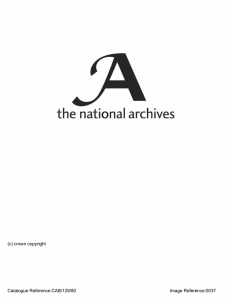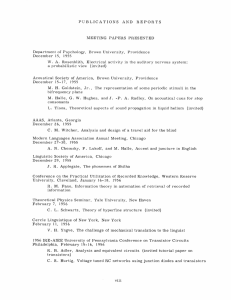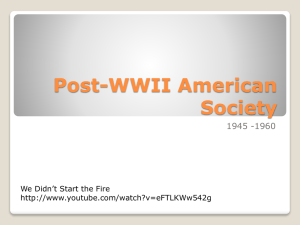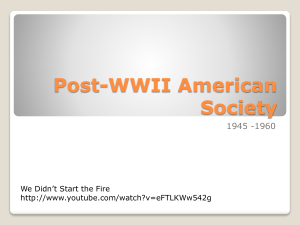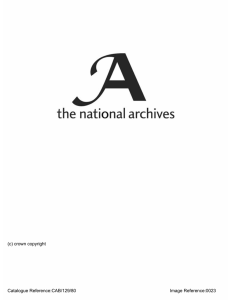1952-1959 Terms
advertisement
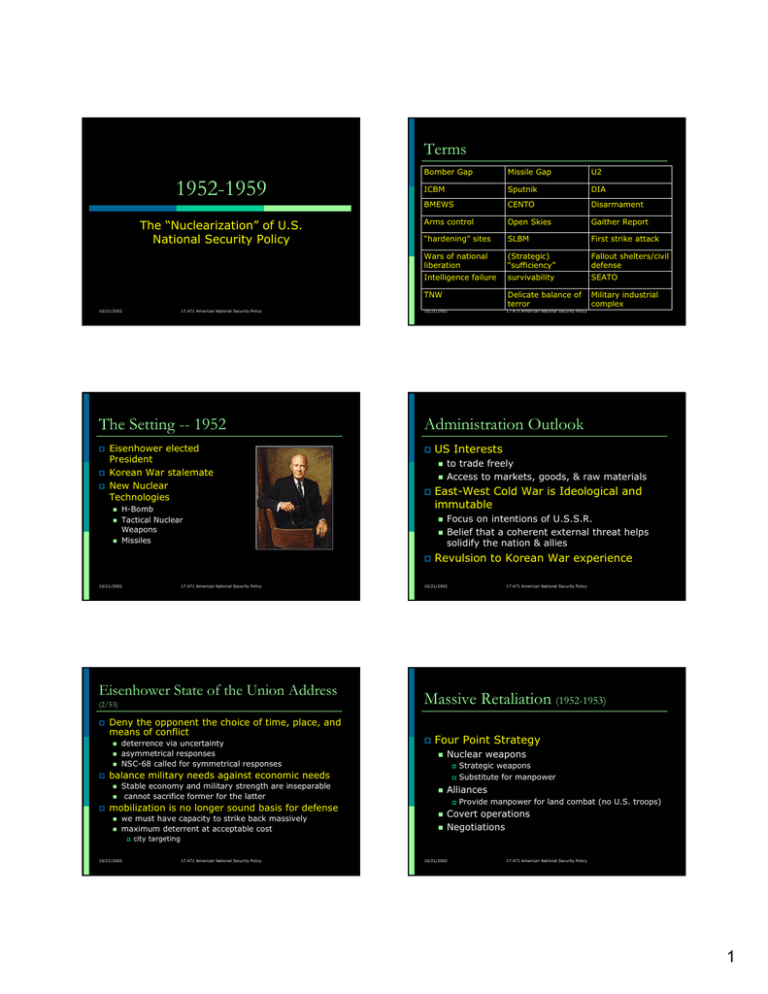
Terms 1952-1959 The “Nuclearization” of U.S. National Security Policy Bomber Gap Missile Gap U2 ICBM Sputnik DIA BMEWS CENTO Disarmament Arms control Open Skies Gaither Report “hardening” sites SLBM First strike attack Wars of national liberation (Strategic) “sufficiency” Fallout shelters/civil defense Intelligence failure survivability SEATO Delicate balance of terror Military industrial complex TNW 10/21/2002 17.471 American National Security Policy The Setting -- 1952 Eisenhower elected President Korean War stalemate New Nuclear Technologies 10/21/2002 Administration Outlook Eisenhower State of the Union Address (2/53) Deny the opponent the choice of time, place, and means of conflict Focus on intentions of U.S.S.R. Belief that a coherent external threat helps solidify the nation & allies Revulsion to Korean War experience 10/21/2002 Stable economy and military strength are inseparable cannot sacrifice former for the latter mobilization is no longer sound basis for defense we must have capacity to strike back massively maximum deterrent at acceptable cost 10/21/2002 17.471 American National Security Policy Massive Retaliation (1952-1953) Four Point Strategy Nuclear weapons balance military needs against economic needs deterrence via uncertainty asymmetrical responses NSC-68 called for symmetrical responses to trade freely Access to markets, goods, & raw materials East-West Cold War is Ideological and immutable 17.471 American National Security Policy US Interests H-Bomb Tactical Nuclear Weapons Missiles 10/21/2002 17.471 American National Security Policy Strategic weapons Substitute for manpower Alliances Covert operations Negotiations Provide manpower for land combat (no U.S. troops) city targeting 17.471 American National Security Policy 10/21/2002 17.471 American National Security Policy 1 New Look NSC 162 strategic nuclear power & air defense development of tactical nuclear weapons to offset manpower U.S. to take the initiative – not react New Look Threat = wars of national liberation (nibbled to death) local wars like Korea to be fought by local forces shift military emphasis to deterrence What Happened? prevent Army from generating large numbers of troops Reduce the Navy Impact US forces droop from 3.5 mill to 2.5 mill by 1960 Military Budget Fixed; Service Budgets Fixed Army CoS Maxwell Taylor resigns in protest MILEXP (1955) ~ 13% GNP MILEXP (1960) ~ 9% GNP 10/21/2002 17.471 American National Security Policy 10/21/2002 17.471 American National Security Policy Events McCarthy & Communist Scare H-Bomb (1952) US TNW (1952) DEW Line authorized (1952) Korean Armistice & U.S.-Korea Security Treaty (1953) Soviet H-Bomb (1953) Iran Crisis (1953) Guatemala Coup (1954) Indo China & SEATO (1954) Taiwan Straits Crisis (1954-1955) Bomber Gap (1955) Open Skies (1955) Austrian Peace Treaty (1955) Warsaw Pact (1955) US TNW to Europe (1955) 10/21/2002 Suez Crisis (1956) Soviet Intervention in Hungry & Poland (1956) U2 Flights Over USSR (1956) U.S. Air Defense & DEW Line (1956) Sputnik, Gaither Report, & the Missile Gap (1957-1960) Taiwan Crises (1957-1958) Jordan Crisis (1957) Lebanon Crisis (1958) Second Berlin Crisis (1958-1961) Nike Zeus ABM Program (19581963) CENTO (1959) Cuba (1959) BMEWS Construction (1959) Eisenhower MIC Speech (1960) 17.471 American National Security Policy 10/21/2002 Guatemala (1954) 10/21/2002 17.471 American National Security Policy End 17.471 American National Security Policy Taiwan Crisis (1954) back 10/21/2002 17.471 American National Security Policy back 2 Southeast Asian Insurgencies (1954) SEATO (1954) 10/21/2002 17.471 American National Security Policy 10/21/2002 17.471 American National Security Policy Tactical Nuclear Weapons Tactical Nuclear Weapons 10/21/2002 10/21/2002 17.471 American National Security Policy Atomic Cannon Testing Nuclear Effects 17.471 American National Security Policy U.S. U.K. France Australia Pakistan Philippines Thailand Cambodia Laos Vietnam back back Bomber Gap (1955) Yucca Flat, Nevada 1951 10/21/2002 17.471 American National Security Policy 10/21/2002 17.471 American National Security Policy back 3 The DEW Line (1956) Distant Early Warning System (1956) 10/21/2002 10/21/2002 17.471 American National Security Policy 17.471 American National Security Policy NATO and the Warsaw Pact (1955) Suez Crisis (1956) 10/21/2002 10/21/2002 17.471 American National Security Policy back Poland & Hungary (1956) 10/21/2002 17.471 American National Security Policy 17.471 American National Security Policy back back Middle East (1957-1958) back 10/21/2002 17.471 American National Security Policy 4 Eisenhower Doctrine U2 Reconnaissance Aircraft Military and economic cooperation with Middle East regimes to ensure regional stability Use U.S. military forces if requested to help resist communist-inspired aggression 10/21/2002 17.471 American National Security Policy back 10/21/2002 Delicate Balance of Terror 17.471 American National Security Policy 17.471 American National Security Policy Jupiter (Army) First strike threat Î bomber dispersal & alert status U.S. MRBMs/IRBMs go to Europe 10/21/2002 CENTO (1959) 10/21/2002 back Sputnik, the Gaither Report, and the Missile Gap The Missile Gap 10/21/2002 17.471 American National Security Policy Thor (AF) 17.471 American National Security Policy BMEWS back 10/21/2002 17.471 American National Security Policy 5 BMEWS (1959) 10/21/2002 17.471 American National Security Policy Cuba back 10/21/2002 17.471 American National Security Policy back Nike Zeus ABM (1960) 10/21/2002 17.471 American National Security Policy back 6
